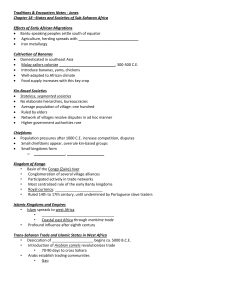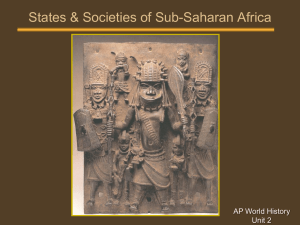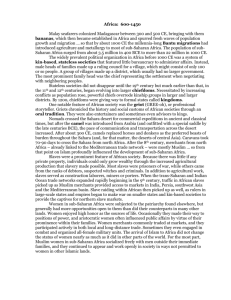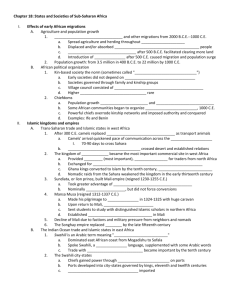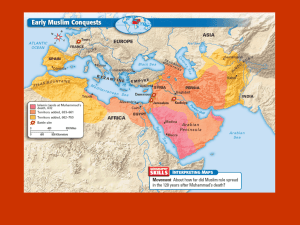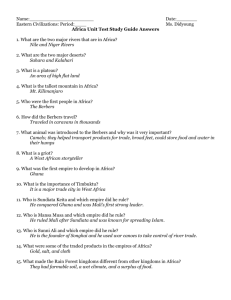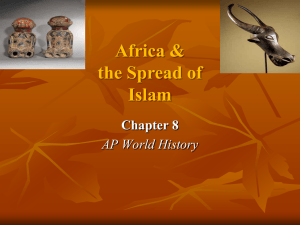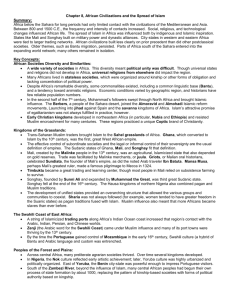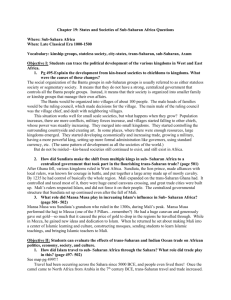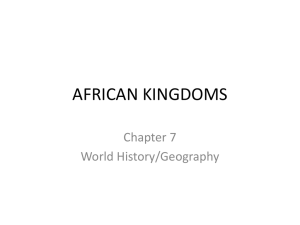Chapter 18 –States and Societies of Sub-Saharan
advertisement
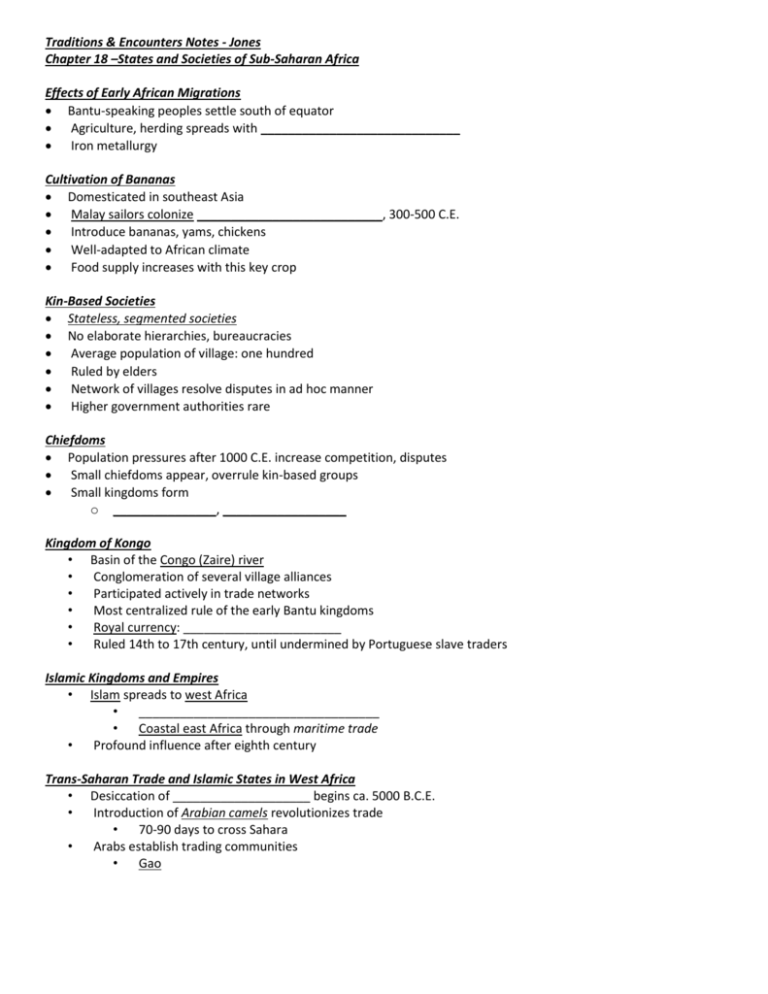
Traditions & Encounters Notes - Jones Chapter 18 –States and Societies of Sub-Saharan Africa Effects of Early African Migrations Bantu-speaking peoples settle south of equator Agriculture, herding spreads with _____________________________ Iron metallurgy Cultivation of Bananas Domesticated in southeast Asia Malay sailors colonize ___________________________, 300-500 C.E. Introduce bananas, yams, chickens Well-adapted to African climate Food supply increases with this key crop Kin-Based Societies Stateless, segmented societies No elaborate hierarchies, bureaucracies Average population of village: one hundred Ruled by elders Network of villages resolve disputes in ad hoc manner Higher government authorities rare Chiefdoms Population pressures after 1000 C.E. increase competition, disputes Small chiefdoms appear, overrule kin-based groups Small kingdoms form o _______________, __________________ Kingdom of Kongo • Basin of the Congo (Zaire) river • Conglomeration of several village alliances • Participated actively in trade networks • Most centralized rule of the early Bantu kingdoms • Royal currency: _______________________ • Ruled 14th to 17th century, until undermined by Portuguese slave traders Islamic Kingdoms and Empires • Islam spreads to west Africa • ___________________________________ • Coastal east Africa through maritime trade • Profound influence after eighth century Trans-Saharan Trade and Islamic States in West Africa • Desiccation of ____________________ begins ca. 5000 B.C.E. • Introduction of Arabian camels revolutionizes trade • 70-90 days to cross Sahara • Arabs establish trading communities • Gao The Kingdom of Ghana • Not related to modern State of Ghana • Developed fourth to fifth century C.E. • Protection against camel-driving raiders • Center of African _______________________ • Imported from south to Ghana • Also sold ivory, slaves Koumbi-Saleh • Capital of kingdom of Ghana • Principal trading center • High point ninth to twelfth century • Population 15,000-20,000 • Military, cultural center Islam in West Africa • Kings of Ghana convert, 10th century • Positive impact on trade, relations with north Africa • Synthesized Islam with local traditions • Nearby Takrur, aggressive missionaries Sundiata (r. 1230-1255) • Empire of _______________ extends over kingdom of Ghana • Neighboring kingdoms as well • Took greater advantage of trans-Saharan trade • Nominally Muslim, but did not force conversions Mansa Musa (r. 1312-1337) • Grand-nephew of Sundiata • Fervent Muslim • Performed hajj in 1324-25 • Constructed numerous mosques • Supported Muslim scholars • Empire declines after his rule Traditions & Encounters Notes - Jones Chapter 18 –States and Societies of Sub-Saharan Africa The Indian Ocean Trade and Islamic States in East Africa • East coast maritime trade weak until 2nd century • Bantu peoples populate coast • Swahili (“______________________”) engage in trade with Arabs • Language a form of Bantu, influenced by Arabic • 10th century, trade increases The Swahili City-States • Great wealth, 11th to 12th century C.E. • Development of city-states • Architecture moved from wood/mud to coral, stone • Chinese silk, porcelain imported Kilwa • • • • City-state on east African coast Fishing, limited trade, 800-1000 C.E. Turn to agriculture, increased trade in pottery and stoneware Major trading center by 14th century • Exporting over a ton of gold per year by 15th century C.E. Zimbabwe • “___________________________” • Stone complex called “Great Zimbabwe” built early 13th century C.E., capital • Population 18,000 in late 15th century • Managed trade between internal and coastal regions Islam in East Africa • Ruling elites in east Africa accept Islam without forcing general population to convert • Often retained pagan religious traditions and practices • Islam serves as social glue with other merchants, states African Society and Cultural Development • Some kingdoms, empires, city-states with well-defined classes • Ruling elites • Merchant class • Peasant class • Other areas in sub-Saharan Africa continue to use traditional _____________________ groups Kinship Groups • Extended families, clans • Idea of private property less prevalent • Land held communally • Harvests distributed by elders Sex and Gender Relations • Men work with specialized skills - Tanning, iron work Heavy labor • Both sexes work in agriculture • Male rule more common, but some expanded roles for women • Merchants, some military activity • Islamic norms slow to penetrate African society Age Grades • From early agricultural period, Sudan • Peer groups of single age cohort • Crosses lines of family and kinship Slavery • Practiced since ancient times • Most slaves captives of war • Debtors • Suspected witches • Criminals • Used principally in agricultural labor • Slaves a form of personal wealth, social status Slave Trading • Increased trans-Saharan and Indian Ocean trade stimulates slave trade, 9th century C.E. • Africa replaces eastern Europe as principal source of slaves • Creates __________________________________________ • More powerful states attack smaller kinship-based groups • 10,000-20,000 slaves per year The Zani Revolt • Slaves from Swahili coast exported to work in Mesopotamia • _______________________ plantations • ____________________ deposits • 869 C.E., slave _______________________________ mounts revolt of 15,000 slaves • Captures Basra - later crushed by Abbasids African Religion • Great diversity of religious belief • Common element: single male __________________________ • Lesser deities associated with natural phenomena • Ancestor worship • ____________________ • Religious specialists, principally men • Oracle reading, spells, other rituals • Limited emphasis on theology • Morality, balance of nature important Early Christianity in North Africa • First century: popular in Egypt, north Africa • Initially weak in sub-Saharan Africa • The ______________________________________, 4th century C.E. • Ethiopia • Merchants, then kings convert • Bible translated into Ethiopian • Isolated during Islamic period, renaissance during twelfth century C.E. • Massive churches carved out of solid rock Ethiopian Christianity • Isolation from other Christian areas until sixteenth century • Independent development • Strong African influenc - Spirit world - Amulets
